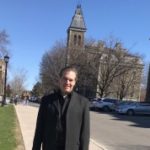Daniel Ness, St. John’s University – The Play-Procedure Continuum
 On St. John’s University Week: Learning and practicing for new teachers can be at odds with each other.
On St. John’s University Week: Learning and practicing for new teachers can be at odds with each other.
Daniel Ness, professor in the department of curriculum and instruction at St. John’s University, determines what this can teach us for future generations of educators.
Daniel Ness holds a Ph.D. from Columbia University’s Graduate School of Arts and Sciences; an M.S. and M.A. from Columbia University, Teachers College; an M.A. from Columbia University, Graduate School of Arts and Sciences; and a B.A. from SUNY at Albany. He is Professor of Curriculum and Instruction. Dr. Ness specializes in spatial development and cognition in STEM curriculum from birth through adolescence. He has taught courses in human development, developmental and cognitive psychology, mathematics, natural sciences, and mathematics and science pedagogical content. He has also developed assessment techniques for diagnosing mathematical and scientific thinking. In addition, Dr. Ness has authored numerous articles on the development of mathematical thinking and spatial and geometric thinking from birth through adolescence. His book, Spatial Intelligence: Why It Matters from Birth through the Lifespan (Routledge) was published in 2017, and his edited book, Alternatives to Privatizing Public Education and Curriculum, has been awarded the 2018 Society of Professors of Education Outstanding Book Award. Dr. Ness’s most recent book project examines the efficacy of what he refers to as visuo-constructive play objects (VCPOs), which include, but are not limited to, play blocks, bricks (e.g., LEGOs), planks, and other constructive play materials.
The Play-Procedure Continuum
The manner in which student teachers learn academic content at the university level and how they practice that content is often contradictory. Education students are often introduced progressive philosophies of learning, such as constructivism, that support higher-order thinking but frequently refrain from applying them in the classroom. My research looks at approaches used by student teachers in a full-year clinically-rich program, which includes a full-time resident faculty member’s on-site participation and where residents’ initial teaching approaches are considered with respect to a Play-Procedure continuum. Data collected were based on biweekly field notes and weekly resident critical self-reflections. Naturalistic observation was employed. Data from field notes and observations as well as critical self-reflections were based on the field experiences of three full-year student teachers. Residents were conflicted about their roles as future teachers in how to approach STEM subjects in schools and what they learned in STEM methods classes. Also identified during the investigation was a powerful and invisible boundary: the school STEM curriculum. While overlap exists between school curriculum and methods curriculum, the former is institutionalized in such a way whereby boundaries are formed in dyads—curriculum and teacher, curriculum and student, curriculum and school administrator, and even curriculum and university faculty member. The development of boundaries in the university-school context is indicative of social norms—such as teacher reputation and school administrator requests—that influence the school-resident relationship. The Play-Procedure Continuum (PPC) in the teaching and learning of mathematics is proposed. The PPC provides an overall gauge that provides indicators of an individual’s mathematical teaching approach—one that in many ways affects the extent to which students learn mathematics.


